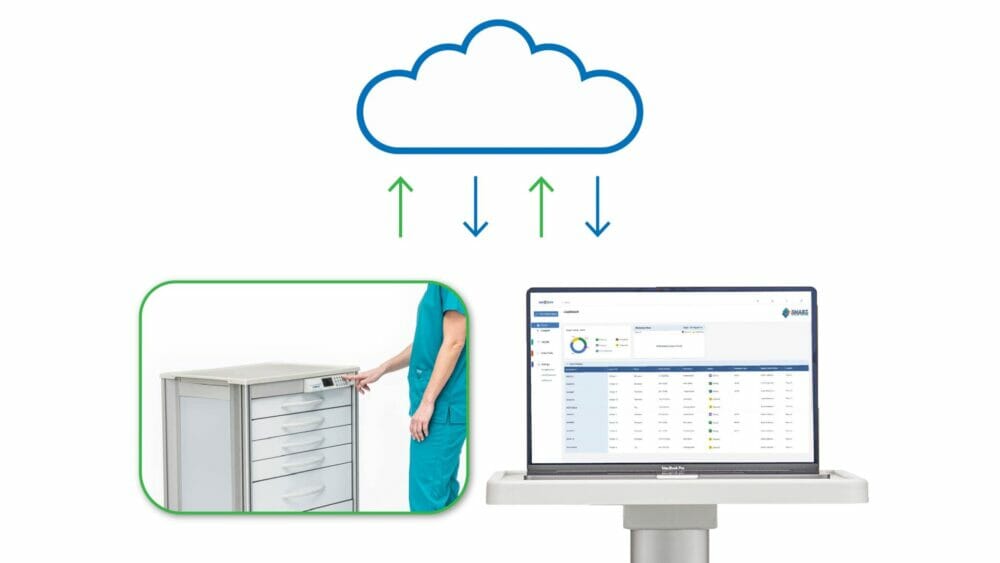
Security is one of the biggest challenges facing the managers of any healthcare facility and locking down patient and financial information is a priority for cybersecurity professionals.
But what about the physical assets of healthcare facilities, such as supplies and expensive equipment?
Can a web-based security system keep supplies secure while tracking individual staff access points? And why would your facility need this information?
This article will examine five benefits of using a web or cloud-based security system to protect your hospital’s physical assets.
But first, we’ll look at two reasons all healthcare facilities should consider using a robust web-based security system rather than a digital system that operates in silos.
Reason #1: Theft
Theft is an ongoing problem for the healthcare system. While patients and visitors are known to swipe hospital gowns, towels, and television remotes, the internet has made it too easy for hospital employees to sell stolen goods online. It’s no surprise that theft costs hospitals millions of dollars.
- In Michigan, two of Beaumont Hospital’s employees stole cystoscopes, ophthalmoscopes, and otoscopes over more than ten years. The devices were then either sold online or sold to a distributor who marketed the stolen devices through their internet supply store.
- Between 2017 and 2019, an employee of Maury Regional Medical Center in Tennessee stole hospital supplies worth almost $800,000 and sold them online.
An integrated cloud-based security system that tracks users and has reporting capabilities may help management detect unusual activity. But financial gain isn’t the only reason people steal from hospitals.
Reason #2: Drug Diversions
The Joint Commission reported that 10% of healthcare workers have a drug abuse problem. Drug diversion, or the illegal use or distribution of prescription drugs, can be hard to detect when employees have access to patient medication, including narcotics.
The Joint Commission recommends that facilities take steps to prevent and detect drug diversion, such as tracking medication by utilizing real-time web-based systems that monitor and report individual access points.
Theft and drug diversion are good reasons to invest in a web-based security system. But there are even more benefits to adopting a centralized security system that tracks users, supplies, and equipment.
Benefits of a Web-Based Security System
Enhanced Efficiency
Digital transformation, or the digitization of physical products or services, is changing the healthcare ecosystem. Technology will likely not replace humans who provide healthcare services, but it can improve and streamline processes and lead to better patient care.
One way to manage access to supplies is by using built-in digital locks. But digital lock systems require management to visit individual carts to add or remove users or check cart status – time that could be used to mentor a new nurse or provide direct patient care.
Modern web-based security systems improve efficiency by allowing hospital management to:
- create reports across all connected supply carts from one centralized computer,
- track user access points,
- receive alerts when batteries are low, carts are off-line, or staff has requested a restock,
- spend less time on paperwork and administrative tasks,
- minimize time spent managing carts on-site, and
- remotely add, remove, or update individual user access.
Additional Security
Cart-based digital lock systems allow management to set up security levels, such as requiring only a pin code or badge swipe, or both. Adopting a web-based interconnected system provides an extra layer of security by allowing management to see what is happening across all web-enabled supply carts.
For example, a web-based security system allows management to:
- add or remove staff access in the system quickly – a critical feature when staff onboard, resign, or relocate to a different area,
- change access information across all connected carts in the event of a lost or stolen badge or pin code, and
- create user access reports to assist in theft or diversion investigations.
Support Documentation for Regulatory Requirements and Compliance Audits
A robust digital tracking system can help a hospital document compliance with internal policies and procedures and the guidelines of regulatory agencies.
For example, a web-based tracking and security system may:
- provide endoscope tracking reports, customized for a compliance audit or
- supply reports verifying regular updates to staff access codes.
Aid Management of Stock Supplies
It can be hard to predict stocking needs in a hospital where every new day brings a different census and variable acuity levels. A web-based system can:
- allow remote restock requests,
- generate reports to determine future stocking needs, and
- provide reports showing the frequency of restocking requests and who requested them.
A note about theft:
Supply theft can go undetected due to the sheer number of staff accessing supply areas and carts. If reports show that the frequency of restocking requests does not align with the census and patient acuity levels, management may consider investigating the discrepancy.
Provide Flexibility
Scalability is a critical feature of any security system that links multiple devices. The system you choose should allow you to:
- add carts or cabinets to your existing web-based security system and
- access the entire system anytime, from anywhere.
A web-based security system should be a part of a layered security strategy that monitors and defends against theft or unauthorized access. And while we did not cover the financial benefit of upgrading a security system, each of the benefits listed above directly impacts a hospital’s bottom line.

Cindy Blye
Content WriterCindy Blye, BSN, RN, CCM is a Registered Nurse and Certified Case Manager. She is an Alumni of West Virginia University School of Nursing (BSN), and a member of the Association of Health Care Journalists and The Authors Guild.
